Effects of Short-Acting Opioids on Intraocular Pressure during General Anesthesia: Systematic Review and Network Meta-Analysis
Abstract
:1. Introduction
2. Methods
2.1. Study Design
2.2. Search Strategy
2.3. Eligibility Criteria
2.4. Risk of Bias Assessment
2.5. Data Extraction
2.6. Statistical Analysis
3. Results
3.1. Study Selection
3.2. Study Characteristics and Risk of Bias
3.3. IOP after Endotracheal Intubation
3.4. IOP after the Administration of Succinylcholine
3.5. Inconsistency
3.6. Publication Bias
4. Discussion
Supplementary Materials
Author Contributions
Funding
Institutional Review Board Statement
Informed Consent Statement
Data Availability Statement
Conflicts of Interest
References
- Wang, Y.X.; Xu, L.; Wei, W.B.; Jonas, J.B. Intraocular pressure and its normal range adjusted for ocular and systemic parameters. The Beijing Eye Study 2011. PLoS ONE 2018, 13, e0196926. [Google Scholar] [CrossRef]
- Chang, C.Y.; Chien, Y.J.; Wu, M.Y. Attenuation of increased intraocular pressure with propofol anesthesia: A systematic review with meta-analysis and trial sequential analysis. J. Adv. Res. 2020, 24, 223–238. [Google Scholar] [CrossRef] [PubMed]
- Shen, Y.; Drum, M.; Roth, S. The prevalence of perioperative visual loss in the United States: A 10-year study from 1996 to 2005 of spinal, orthopedic, cardiac, and general surgery. Anesth. Analg. 2009, 109, 1534–1545. [Google Scholar] [CrossRef] [PubMed]
- Guihard, B.; Chollet-Xemard, C.; Lakhnati, P.; Vivien, B.; Broche, C.; Savary, D.; Ricard-Hibon, A.; Marianne Dit Cassou, P.J.; Adnet, F.; Wiel, E.; et al. Effect of Rocuronium vs Succinylcholine on Endotracheal Intubation Success Rate among Patients Undergoing Out-of-Hospital Rapid Sequence Intubation: A Randomized Clinical Trial. JAMA 2019, 322, 2303–2312. [Google Scholar] [CrossRef] [PubMed]
- Chidiac, E.J.; Raiskin, A.O. Succinylcholine and the open eye. Ophthalmol. Clin. N. Am. 2006, 19, 279–285. [Google Scholar] [CrossRef]
- Chang, C.Y.; Chen, H.A.; Chien, Y.J.; Wu, M.Y. Attenuation of the increase in intraocular pressure with dexmedetomidine: Systematic review with meta-analysis and trial sequential analysis. J. Clin. Anesth. 2021, 68, 110065. [Google Scholar] [CrossRef] [PubMed]
- Casati, A.; Fanelli, G.; Albertin, A.; Deni, F.; Danelli, G.; Grifoni, F.; Torri, G. Small doses of remifentanil or sufentanil for blunting cardiovascular changes induced by tracheal intubation: A double-blind comparison. Eur. J. Anaesthesiol. 2001, 18, 108–112. [Google Scholar] [CrossRef] [PubMed]
- Kelly, H.E.; Shaw, G.M.; Brett, C.N.; Greenwood, F.M.; Huckabee, M.L. The effect of titrated fentanyl on suppressed cough reflex in healthy adult volunteers. Anaesthesia 2016, 71, 529–534. [Google Scholar] [CrossRef] [PubMed]
- Pouraghaei, M.; Moharamzadeh, P.; Soleimanpour, H.; Rahmani, F.; Safari, S.; Mahmoodpoor, A.; Bakhtavar, H.E.; Esfanjani, R.M. Comparison between the effects of alfentanil, fentanyl and sufentanil on hemodynamic indices during rapid sequence intubation in the emergency department. Anesth. Pain Med. 2014, 4, e14618. [Google Scholar] [CrossRef] [PubMed]
- Alexander, R.; Hill, R.; Lipham, W.J.; Weatherwax, K.J.; el-Moalem, H.E. Remifentanil prevents an increase in intraocular pressure after succinylcholine and tracheal intubation. Br. J. Anaesth. 1998, 81, 606–607. [Google Scholar] [CrossRef]
- Eti, Z.; Yayci, A.; Umuroǧlu, T.; Göǧü, F.Y.; Bozkurt, N. The effect of propofol and alfentanil on the increase in intraocular pressure due to succinylcholine and intubation. Eur. J. Ophthalmol. 2000, 10, 105–109. [Google Scholar] [CrossRef] [PubMed]
- Zimmerman, A.A.; Funk, K.J.; Tidwell, J.L. Propofol and alfentanil prevent the increase in intraocular pressure caused by succinylcholine and endotracheal intubation during a rapid sequence induction of anesthesia. Anesth. Analg. 1996, 83, 814–817. [Google Scholar] [CrossRef] [PubMed]
- Ng, H.P.; Chen, F.G.; Yeong, S.M.; Wong, E.; Chew, P. Effect of remifentanil compared with fentanyl on intraocular pressure after succinylcholine and tracheal intubation. Br. J. Anaesth. 2000, 85, 785–787. [Google Scholar] [CrossRef] [PubMed]
- Sator-Katzenschlager, S.M.; Oehmke, M.J.; Deusch, E.; Dolezal, S.; Heinze, G.; Wedrich, A. Effects of remifentanil and fentanyl on intraocular pressure during the maintenance and recovery of anaesthesia in patients undergoing non-ophthalmic surgery. Eur. J. Anaesthesiol. 2004, 21, 95–100. [Google Scholar] [CrossRef] [PubMed]
- Hutton, B.; Salanti, G.; Caldwell, D.M.; Chaimani, A.; Schmid, C.H.; Cameron, C.; Ioannidis, J.P.; Straus, S.; Thorlund, K.; Jansen, J.P.; et al. The PRISMA extension statement for reporting of systematic reviews incorporating network meta-analyses of health care interventions: Checklist and explanations. Ann. Intern. Med. 2015, 162, 777–784. [Google Scholar] [CrossRef] [PubMed]
- Sterne, J.A.C.; Savovic, J.; Page, M.J.; Elbers, R.G.; Blencowe, N.S.; Boutron, I.; Cates, C.J.; Cheng, H.Y.; Corbett, M.S.; Eldridge, S.M.; et al. RoB 2: A revised tool for assessing risk of bias in randomised trials. BMJ 2019, 366, l4898. [Google Scholar] [CrossRef] [PubMed]
- Rohatgi, A. WebPlotDigitizer (Version 4.4). Available online: https://automeris.io/WebPlotDigitizer (accessed on 7 June 2021).
- Drevon, D.; Fursa, S.R.; Malcolm, A.L. Intercoder Reliability and Validity of WebPlotDigitizer in Extracting Graphed Data. Behav. Modif. 2017, 41, 323–339. [Google Scholar] [CrossRef] [PubMed]
- Wan, X.; Wang, W.; Liu, J.; Tong, T. Estimating the sample mean and standard deviation from the sample size, median, range and/or interquartile range. BMC Med. Res. Methodol. 2014, 14, 135. [Google Scholar] [CrossRef] [PubMed]
- Higgins, J.P.T.; Thomas, J.; Chandler, J.; Cumpston, M.; Li, T.; Page, M.J.; Welch, V.A. Cochrane Handbook for Systematic Reviews of Interventions Version 6.3 (Updated February 2022). 2022. Available online: www.training.cochrane.org/handbook (accessed on 7 August 2022).
- White, I.R. Network meta-analysis. Stata J. 2015, 15, 951–985. [Google Scholar] [CrossRef]
- Salanti, G.; Ades, A.E.; Ioannidis, J.P. Graphical methods and numerical summaries for presenting results from multiple-treatment meta-analysis: An overview and tutorial. J. Clin. Epidemiol. 2011, 64, 163–171. [Google Scholar] [CrossRef] [PubMed]
- Wu, Y.C.; Shih, M.C.; Tu, Y.K. Using Normalized Entropy to Measure Uncertainty of Rankings for Network Meta-analyses. Med. Decis. Mak. 2021, 41, 706–713. [Google Scholar] [CrossRef] [PubMed]
- Higgins, J.P.; Jackson, D.; Barrett, J.K.; Lu, G.; Ades, A.E.; White, I.R. Consistency and inconsistency in network meta-analysis: Concepts and models for multi-arm studies. Res. Synth. Methods 2012, 3, 98–110. [Google Scholar] [CrossRef] [PubMed]
- Dias, S.; Welton, N.J.; Caldwell, D.M.; Ades, A.E. Checking consistency in mixed treatment comparison meta-analysis. Stat. Med. 2010, 29, 932–944. [Google Scholar] [CrossRef] [PubMed]
- Chaimani, A.; Higgins, J.P.; Mavridis, D.; Spyridonos, P.; Salanti, G. Graphical tools for network meta-analysis in STATA. PLoS ONE 2013, 8, e76654. [Google Scholar] [CrossRef]
- Akhavanakbari, G.; Entezariasl, M.; Ojagi, H.; Isazadehfar, K. Comparison of the effects of remifentanil and alfentanil on intraocular pressure in cataract surgery. Saudi J. Anaesth. 2013, 7, 160–164. [Google Scholar] [CrossRef] [PubMed]
- Polarz, H.; Böhrer, H.; Fleischer, F.; Huster, T.; Bauer, H.; Wolfrum, J. Effects of thiopentone/suxamethonium on intraocular pressure after pretreatment with alfentanil. Eur. J. Clin. Pharmacol. 1992, 43, 311–313. [Google Scholar] [CrossRef] [PubMed]
- Sweeney, J.; Underhill, S.; Dowd, T.; Mostafa, S.M. Modification by fentanyl and alfentanil of the intraocular pressure response to suxamethonium and tracheal intubation. Br. J. Anaesth. 1989, 63, 688–691. [Google Scholar] [CrossRef]
- Kaygusuz, K.; Toker, M.I.; Kol, I.O.; Erdogan, H.; Gursoy, S.; Mimaroglu, C. The effects of different doses of remifentanil on intraocular pressure after tracheal intubation: A randomized, double-blind and prospective study. Ann. Ophthalmol. 2007, 39, 198–204. [Google Scholar] [CrossRef]
- Cook, J.H. The effect of suxamethonium on intraocular pressure. Anaesthesia 1981, 36, 359–365. [Google Scholar] [CrossRef] [PubMed]
- Kelly, R.E.; Dinner, M.; Turner, L.S.; Haik, B.; Abramson, D.H.; Daines, P. Succinylcholine increases intraocular pressure in the human eye with the extraocular muscles detached. Anesthesiology 1993, 79, 948–952. [Google Scholar] [CrossRef] [PubMed]
- Kayhan, Z.; Aldemir, D.; Mutlu, H.; Ogus, E. Which is responsible for the haemodynamic response due to laryngoscopy and endotracheal intubation? Catecholamines, vasopressin or angiotensin? Eur. J. Anaesthesiol. 2005, 22, 780–785. [Google Scholar] [CrossRef]
- Robinson, R.; White, M.; McCann, P.; Magner, J.; Eustace, P. Effect of anaesthesia on intraocular blood flow. Br. J. Ophthalmol. 1991, 75, 92–93. [Google Scholar] [CrossRef] [PubMed]
- Cunningham, A.J.; Barry, P. Intraocular pressure-physiology and implications for anaesthetic management. Can. Anaesth. Soc. J. 1986, 33, 195–208. [Google Scholar] [CrossRef] [PubMed]
- Beers, R.; Camporesi, E. Remifentanil update: Clinical science and utility. CNS Drugs 2004, 18, 1085–1104. [Google Scholar] [CrossRef]
- Glass, P.S.; Hardman, D.; Kamiyama, Y.; Quill, T.J.; Marton, G.; Donn, K.H.; Grosse, C.M.; Hermann, D. Preliminary pharmacokinetics and pharmacodynamics of an ultra-short-acting opioid: Remifentanil (GI87084B). Anesth. Analg. 1993, 77, 1031–1040. [Google Scholar] [CrossRef]
- Larijani, G.E.; Goldberg, M.E. Alfentanil hydrochloride: A new short-acting narcotic analgesic for surgical procedures. Clin. Pharm. 1987, 6, 275–282. [Google Scholar] [PubMed]


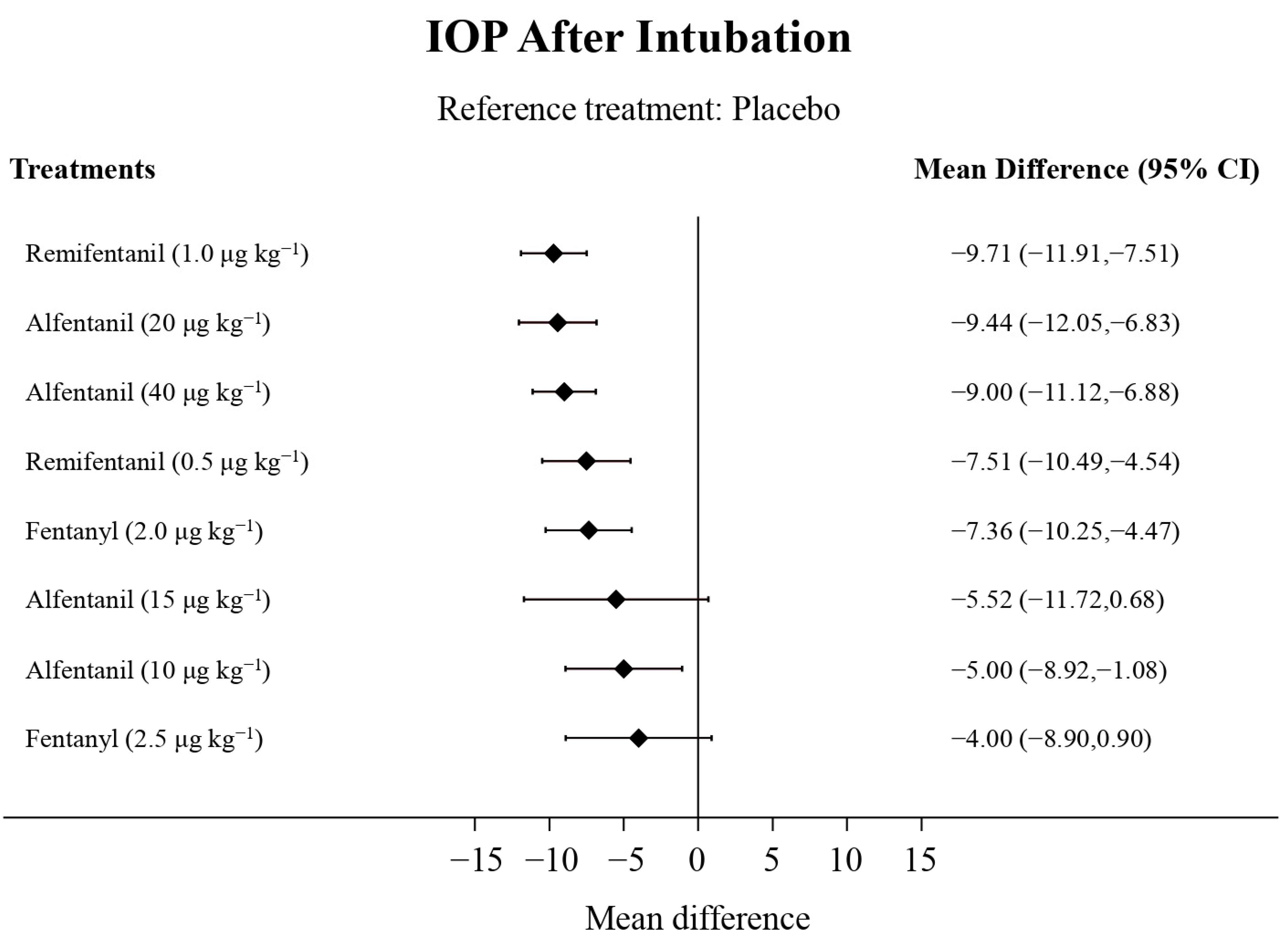

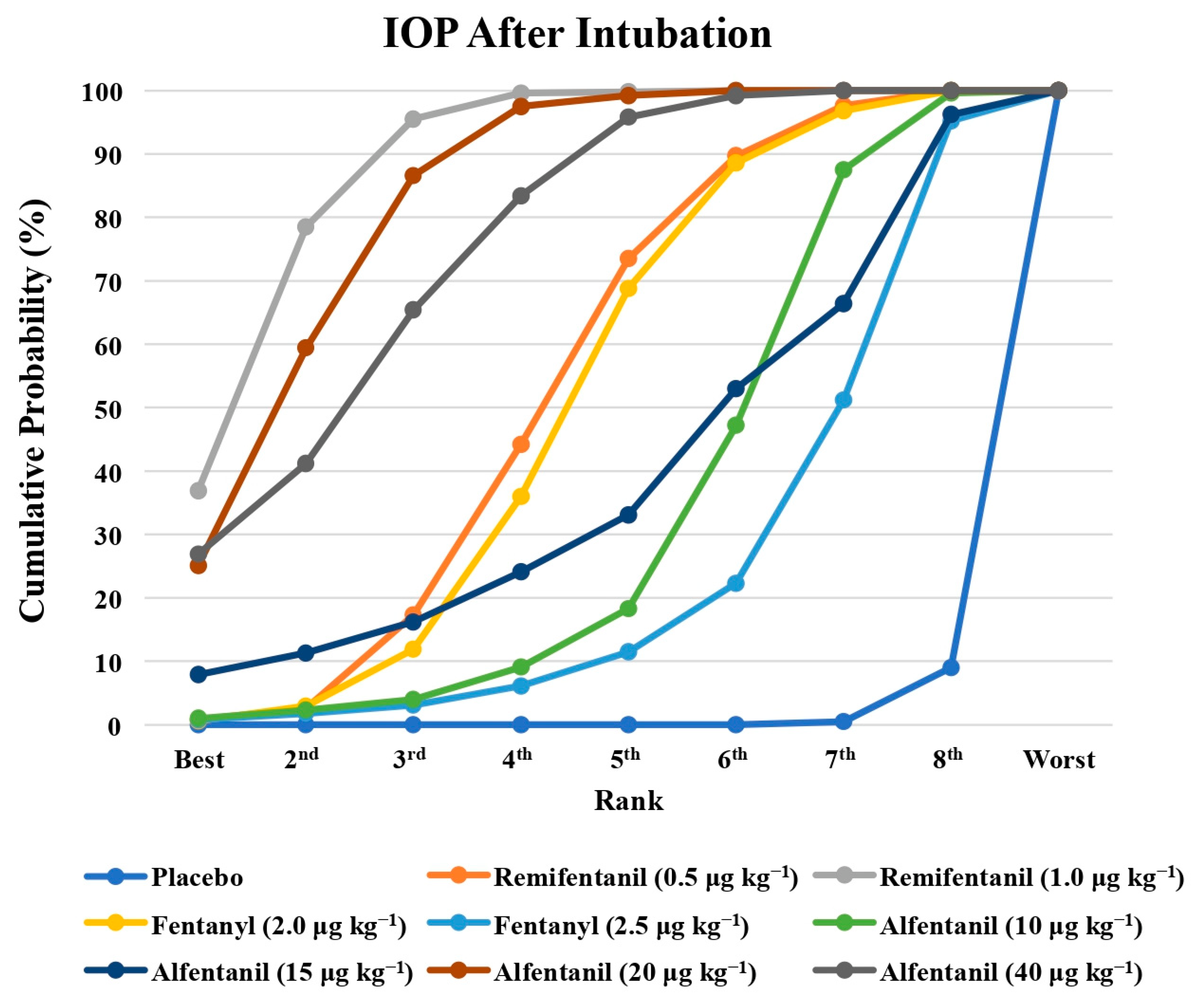
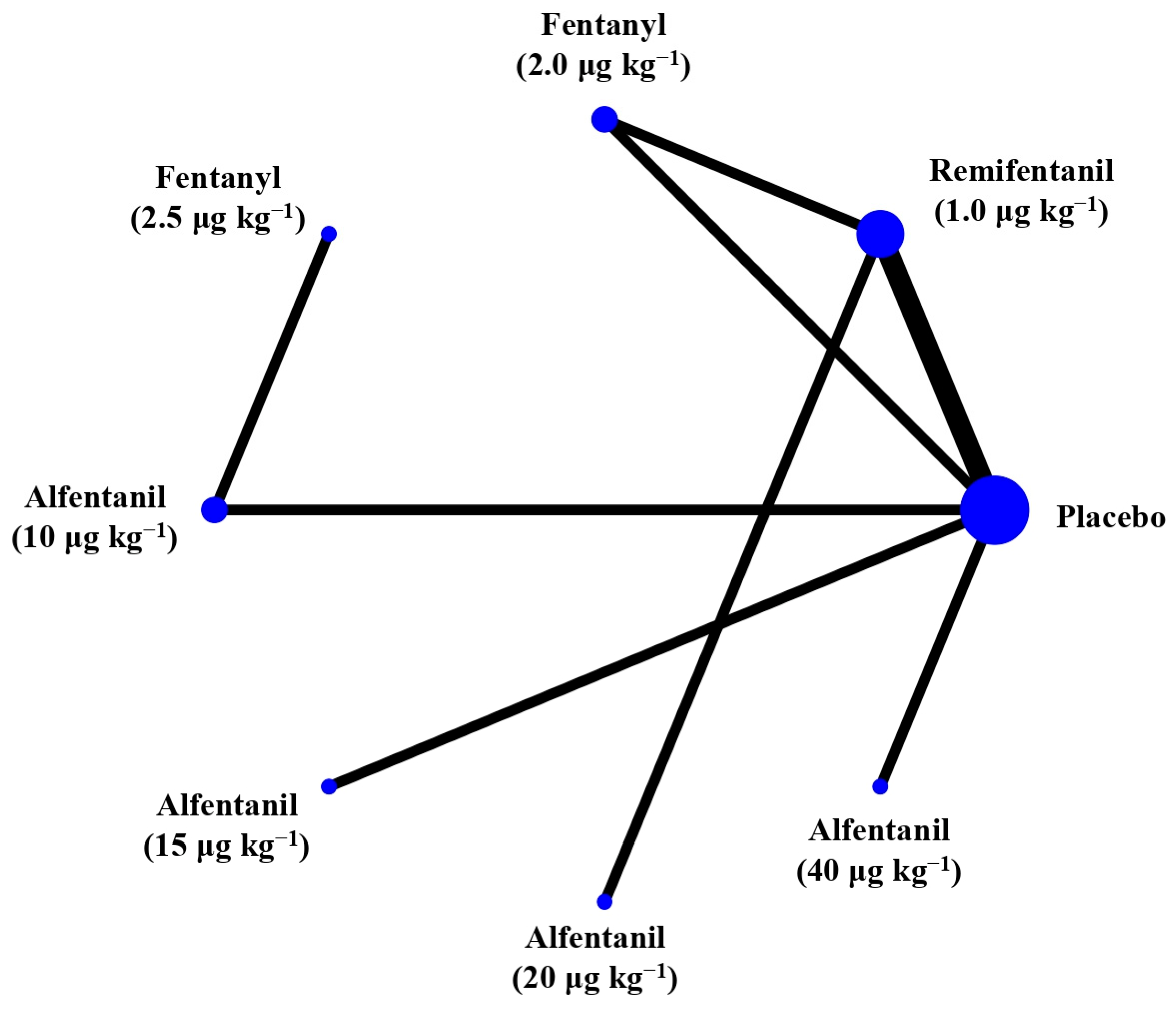
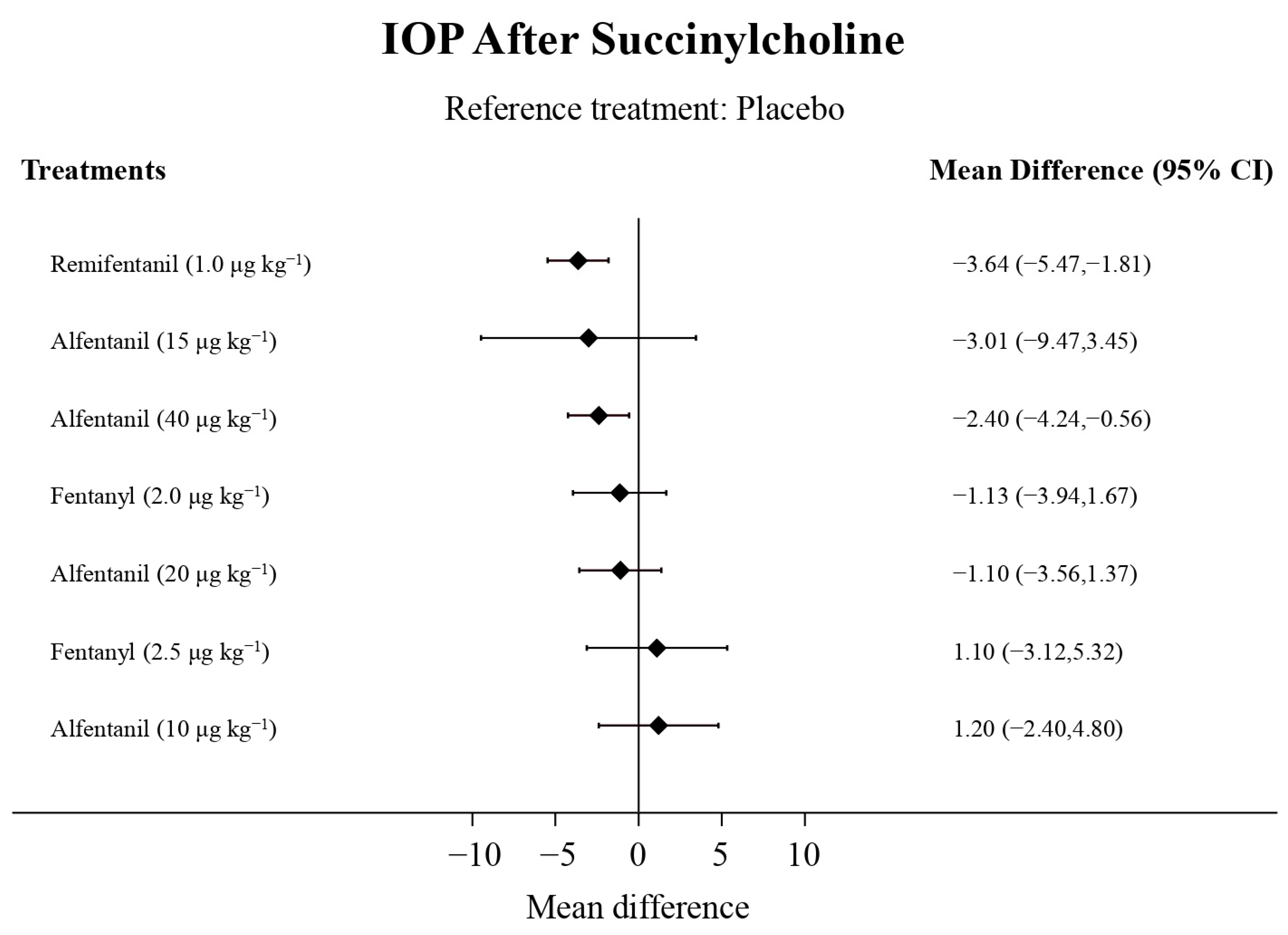
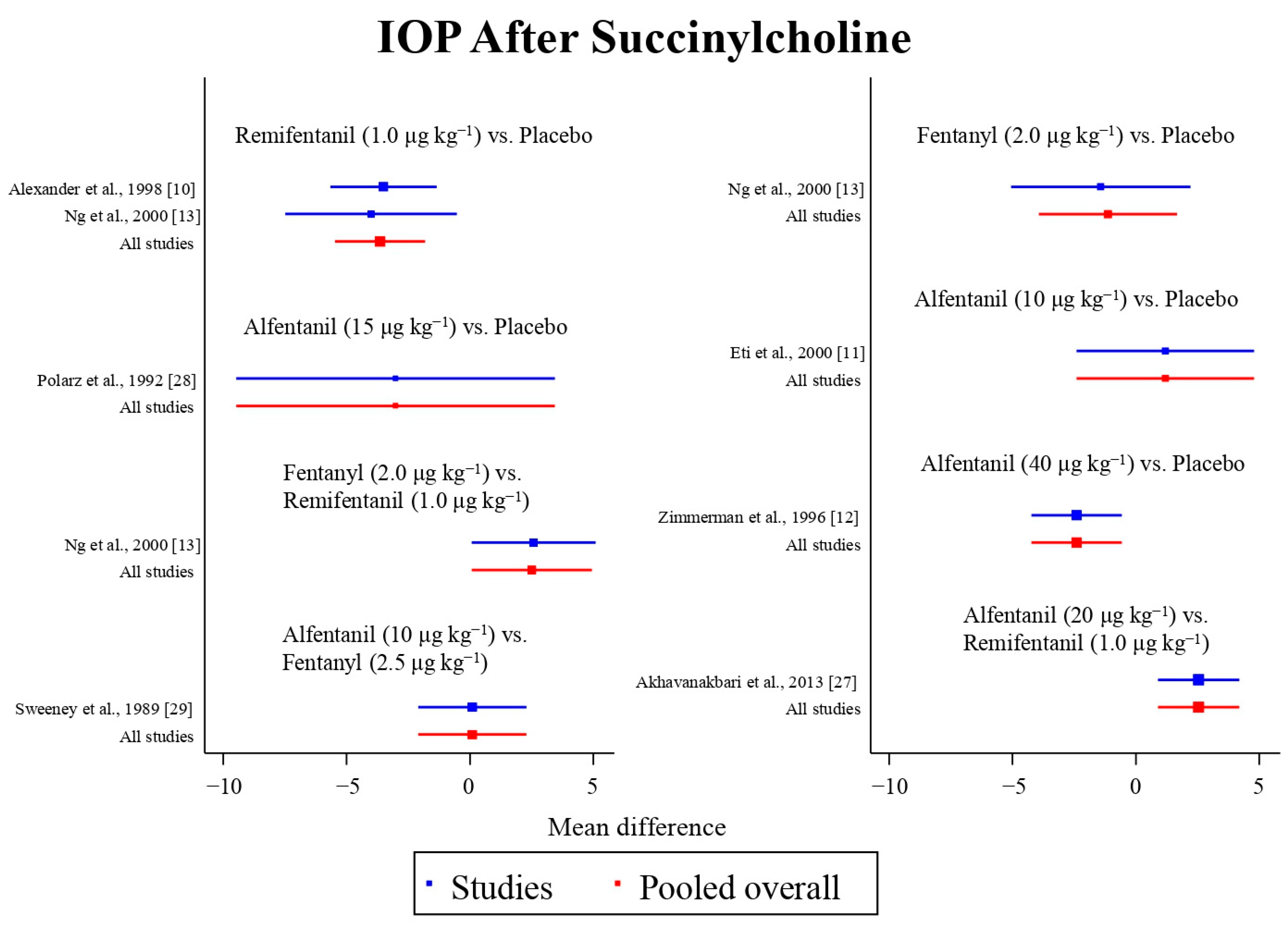

| Study | Location | Surgery | Sample Size | Mean Age | Intervention Arm | Anesthesia Regimen |
|---|---|---|---|---|---|---|
| Akhavanakbari et al., 2013 [27] | Iran | Elective cataract surgery | 50 | 69.1 |
| Induction: thiopental (5 mg kg−1), succinylcholine (1 mg kg−1) Maintenance: propofol (100 μg kg−1 min−1), atracurium (0.1–0.2 mg kg−1), remifentanil (0.1 μg kg−1 min−1) or alfentanil (0.5 μg kg−1 min−1) |
| Kaygusuz et al., 2007 [30] | Turkey | Elective non-ophthalmic surgery left | 60 | 30.0 |
| Premedication: midazolam (0.07 mg kg−1) intramuscularly 30 min before induction Induction: propofol (2 mg kg−1), vecuronium (0.1 mg kg−1), study drugs injected by diluting with 5 mL normal saline immediately following induction agents Maintenance: 2% sevoflurane |
| Sator-Katzenschlager et al., 2004 [14] | Vienna | Elective non-ophthalmic surgery both | 32 | 53.0 |
| Premedication: midazolam (7.5 mg) orally 1 h before surgery Induction: propofol (2 mg kg−1), vecuronium (0.1 mg kg−1) Maintenance: propofol (4–8 mg kg−1 h−1), vecuronium (0.03 mg kg−1), remifentanil (0.25–0.5 μg kg−1 min−1), fentanyl (2–5 μg kg−1 bolus doses as clinically indicated) |
| Eti et al., 2000 [11] | Turkey | Elective non-ophthalmic surgery right | 40 | 34.6 |
| Induction regimens have been described in the intervention arm column |
| Ng et al., 2000 [13] | Singapore | Elective surgery left | 45 | 32.8 |
| Premedication: amethocaine 1% drops instilled on patient’s left eye Induction: thiopental (5 mg kg−1), succinylcholine (2 mg kg−1) Maintenance: 1% isoflurane, atracurium |
| Alexander et al., 1998 [10] | North Carolina, USA | Elective eye surgery | 30 | 59.1 |
| Premedication: midazolam (0.03 mg kg−1), tetracaine 0.5% drops to non-operated eye Induction: propofol (2 mg kg−1), succinylcholine (1 mg kg−1) Maintenance: 1% isoflurane |
| Zimmerman et al., 1996 [12] | California, USA | Elective non-ophthalmic Surgery left | 60 | 30.0 |
| Premedication: midazolam (1–2 mg, at the discretion of the anesthesia team), proparacaine (0.5%, one drop in patient’s left eye), lidocaine (0.5 mg kg−1) Induction regimens have been described in the intervention arm column |
| Polarz et al., 1992 [28] | Heidelberg, Germany | Ophthalmic surgery | 40 | 73.8 |
| Premedication: midazolam (0.06 mg kg−1) and atropine (0.01 mg kg−1) intramuscularly Induction: vecuronium (0.01 mg kg−1), thiopentone (3–4 mg kg−1), succinylcholine (1 mg kg−1) Maintenance: 0.5–0.8% isoflurane, vecuronium |
| Sweeney et al., 1989 [29] | Liverpool, England | Routine ophthalmic operations | 40 | 65.9 |
| Premedication: 0.4% benoxinate (one or two drops), diazepam (5–10 mg orally two hours before operation) Induction: thiopentone (2–4 mg kg−1), succinylcholine 1.5 mg Maintenance: 0.8% enflurane, atracurium (0.6 mg kg−1) |
| Placebo | 10.10 (7.87, 12.33) | 0.93 (−4.18, 6.03) | 5.00 (1.08, 8.92) | 5.52 (−0.68, 11.72) | 9.00 (6.88, 11.12) | |||
| 7.51 (4.54, 10.49) | Remifentanil (0.5 μg kg−1) | 2.20 (0.20, 4.20) | 1.93 (−0.33, 4.19) | |||||
| 9.71 (7.51, 11.91) | 2.20 (0.20, 4.20) | Remifentanil (1.0 μg kg−1) | −2.03 (−4.10, 0.04) | −0.27 (−1.67, 1.13) | ||||
| 7.36 (4.47, 10.25) | −0.15 (−3.02, 2.71) | −2.35 (−4.41, −0.29) | Fentanyl (2.0 μg kg−1) | |||||
| 4.00 (−0.90, 8.90) | −3.51 (−9.25, 2.22) | −5.71 (−11.08, −0.34) | −3.36 (−9.05, 2.33) | Fentanyl (2.5 μg kg−1) | 1.00 (−1.94, 3.94) | |||
| 5.00 (1.08, 8.92) | −2.51 (−7.43, 2.41) | −4.71 (−9.20, −0.21) | −2.36 (−7.23, 2.51) | 1.00 (−1.94, 3.94) | Alfentanil (10 μg kg−1) | |||
| 5.52 (−0.68, 11.72) | −1.99 (−8.87, 4.89) | −4.19 (−10.77, 2.39) | −1.84 (−8.68, 5.00) | 1.52 (−6.38, 9.42) | 0.52 (−6.81, 7.86) | Alfentanil (15 μg kg−1) | ||
| 9.44 (6.83, 12.05) | 1.93 (−0.33, 4.19) | −0.27 (−1.67, 1.13) | 2.08 (−0.40, 4.57) | 5.44 (−0.11, 10.99) | 4.44 (−0.27, 9.15) | 3.92 (−2.81, 10.65) | Alfentanil (20 μg kg−1) | |
| 9.00 (6.88, 11.12) | 1.49 (−2.17, 5.14) | −0.71 (−3.76, 2.35) | 1.64 (−1.94, 5.22) | 5.00 (−0.34, 10.34) | 4.00 (−0.45, 8.45) | 3.48 (−3.07, 10.03) | −0.44 (−3.80, 2.92) | Alfentanil (40 μg kg−1) |
| Intraocular Pressure Measured after Endotracheal Intubation | ||
| Treatments | SUCRA | NE |
| Remifentanil (1.0 μg kg−1) | 0.89 | 0.54 |
| Alfentanil (20 μg kg−1) | 0.84 | 0.65 |
| Alfentanil (40 μg kg−1) | 0.77 | 0.77 |
| Remifentanil (0.5 μg kg−1) | 0.53 | 0.77 |
| Fentanyl (2.0 μg kg−1) | 0.51 | 0.76 |
| Alfentanil (15 μg kg−1) | 0.39 | 0.89 |
| Alfentanil (10 μg kg−1) | 0.34 | 0.70 |
| Fentanyl (2.5 μg kg−1) | 0.24 | 0.69 |
| Placebo | 0.01 | 0.15 |
| Intraocular Pressure Measured after the Administration of Succinylcholine | ||
| Treatments | SUCRA | NE |
| Remifentanil (1.0 μg kg−1) | 0.91 | 0.47 |
| Alfentanil (40 μg kg−1) | 0.71 | 0.75 |
| Alfentanil (15 μg kg−1) | 0.70 | 0.86 |
| Fentanyl (2.0 μg kg−1) | 0.51 | 0.89 |
| Alfentanil (20 μg kg−1) | 0.51 | 0.84 |
| Placebo | 0.29 | 0.70 |
| Fentanyl (2.5 μg kg−1) | 0.20 | 0.77 |
| Alfentanil (10 μg kg−1) | 0.17 | 0.70 |
| Placebo | 3.64 (1.81, 5.47) | 1.42 (−2.22, 5.06) | −1.20 (−4.80, 2.40) | 3.01 (−3.45, 9.47) | 2.40 (0.56, 4.24) | ||
| 3.64 (1.81, 5.47) | Remifentanil (1.0 μg kg−1) | −2.58 (−5.10, −0.07) | −2.54 (−4.19, −0.90) | ||||
| 1.13 (−1.67, 3.94) | −2.51 (−4.94, −0.07) | Fentanyl (2.0 μg kg−1) | |||||
| −1.10 (−5.32, 3.12) | −4.74 (−9.34, −0.14) | −2.23 (−7.30, 2.83) | Fentanyl (2.5 μg kg−1) | −0.10 (−2.30, 2.10) | |||
| −1.20 (−4.80, 2.40) | −4.84 (−8.88, −0.80) | −2.33 (−6.89, 2.23) | −0.10 (−2.30, 2.10) | Alfentanil (10 μg kg−1) | |||
| 3.01 (−3.45, 9.47) | −0.63 (−7.34, 6.08) | 1.88 (−5.16, 8.91) | 4.11 (−3.60, 11.82) | 4.21 (−3.18, 11.60) | Alfentanil (15 μg kg−1) | ||
| 1.10 (−1.37, 3.56) | −2.54 (−4.19, −0.90) | −0.04 (−2.98, 2.90) | 2.20 (−2.69, 7.08) | 2.30 (−2.07, 6.66) | −1.91 (−8.83, 5.00) | Alfentanil (20 μg kg−1) | |
| 2.40 (0.56, 4.24) | −1.24 (−3.83, 1.35) | 1.27 (−2.08, 4.62) | 3.50 (−1.10, 8.10) | 3.60 (−0.44, 7.64) | −0.61 (−7.32, 6.10) | 1.30 (−1.77, 4.38) | Alfentanil (40 μg kg−1) |
Publisher’s Note: MDPI stays neutral with regard to jurisdictional claims in published maps and institutional affiliations. |
© 2022 by the authors. Licensee MDPI, Basel, Switzerland. This article is an open access article distributed under the terms and conditions of the Creative Commons Attribution (CC BY) license (https://creativecommons.org/licenses/by/4.0/).
Share and Cite
Huang, J.-Y.; Shih, P.-C.; Chen, C.-T.; Lin, H.-Y.; Chien, Y.-J.; Wu, M.-Y.; Chen, C.-H.; Chang, C.-Y. Effects of Short-Acting Opioids on Intraocular Pressure during General Anesthesia: Systematic Review and Network Meta-Analysis. Pharmaceuticals 2022, 15, 989. https://doi.org/10.3390/ph15080989
Huang J-Y, Shih P-C, Chen C-T, Lin H-Y, Chien Y-J, Wu M-Y, Chen C-H, Chang C-Y. Effects of Short-Acting Opioids on Intraocular Pressure during General Anesthesia: Systematic Review and Network Meta-Analysis. Pharmaceuticals. 2022; 15(8):989. https://doi.org/10.3390/ph15080989
Chicago/Turabian StyleHuang, Jian-You, Ping-Cheng Shih, Chu-Ting Chen, Han-Yu Lin, Yung-Jiun Chien, Meng-Yu Wu, Chih-Hao Chen, and Chun-Yu Chang. 2022. "Effects of Short-Acting Opioids on Intraocular Pressure during General Anesthesia: Systematic Review and Network Meta-Analysis" Pharmaceuticals 15, no. 8: 989. https://doi.org/10.3390/ph15080989
APA StyleHuang, J.-Y., Shih, P.-C., Chen, C.-T., Lin, H.-Y., Chien, Y.-J., Wu, M.-Y., Chen, C.-H., & Chang, C.-Y. (2022). Effects of Short-Acting Opioids on Intraocular Pressure during General Anesthesia: Systematic Review and Network Meta-Analysis. Pharmaceuticals, 15(8), 989. https://doi.org/10.3390/ph15080989








